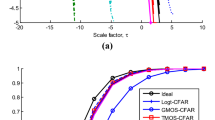Abstract
This paper deals with the constant false alarm rate (CFAR) radar detection of targets embedded in Pearson distributed clutter. We develop new CFAR detection algorithms-notably cell averaging (CA), greatest of selection (GO) and smallest of selection SO-CFAR operating in Pearson measurements based on a non-linear compression method for spiky clutter reduction. The technique is similar to that used in non uniform quantization where a different law is used. It consists of compressing the output square law detector noisy signal with respect to a non-linear law in order to reduce the effect of impulsive noise level. Thus, it can be used as a pre-processing step to improve the performance of automatic target detection especially in lower generalised signal-to-noise ratio (GSNR). The performance characteristics of the proposed CFAR detectors are presented for different values of the compression parameter. We demonstrate, via simulation results, that the pre-processed compression procedure is computationally efficient and can significantly enhance detection performance.
Similar content being viewed by others
References
Skolnik, M.I.: Introduction to Radar Systems, 3rd edn. McGraw-Hill, New York (2001)
Finn, H.M., Johnson, R.S.: Adaptive detection mode with threshold control as a function of spatially sampled clutter level estimate. In: RCA Review, pp. 414–464, 29 September 1968
Morris, G.: Airborne Pulsed Doppler Radar Systems, Artech House, Norwood (1996)
Antonik, P., Bowies, B., Caprao, G., Hennington, L.: Intelligent Use of CFAR, Kaman Science Corporation, Utica (1991)
Trunk, G.V.: Range resolution of targets using automatic detection. IEEE Trans. Aerosp. Electron. Syst. AES-14(5), 750–755 (1978)
Hansen, V.G., Sawyers, J.H.: Detectability loss due to greatest selection in a cell averaging CFAR. IEEE Trans. Aerosp. Electron. Syst. AES-16, 115–118 (1980)
Tsakalides, P., Trinci, P., Nikias, C.L.: Performance assessment of CFAR processors in Pearson-distributed clutter. IEEE Trans. Aerosp. Electron. Syst. AES-36(4), 1377–1386 (2000)
Pierce, R.D.: Application of the positive alpha-stable distribution. IEEE Signal Processing Workshop on Higher-Order Statistics, Banff, Alberta, Canada, pp. 420–424, July 21–23 1997
Tsaklides, P., Nikias, C.L.: Robust space-time adaptive processing (STAP) in non-gaussian clutter environments. IEE Proc. Radar Sonar Navigation 146, 84–94 (1999)
Nikias, C.L., Shao, M.: Signal Processing with Alpha-Stable Distributions and Applications. Wiley, London (1995)
Jayant, N., Noll, P.: Digital Coding of Waveforms: Principles and Applications to Speech and Video. Prentice-Hall, New York (1984)
Papoulis, A.: Probability Random Variables and Stochastic Processes, 3rd edn. McGraw-Hill, New York (1991)
Author information
Authors and Affiliations
Corresponding author
Rights and permissions
About this article
Cite this article
Messali, Z., Soltani, F. & Sahmoudi, M. Robust radar detection of CA, GO and SO CFAR in Pearson measurements based on a non linear compression procedure for clutter reduction. SIViP 2, 169–176 (2008). https://doi.org/10.1007/s11760-007-0045-0
Received:
Revised:
Accepted:
Published:
Issue Date:
DOI: https://doi.org/10.1007/s11760-007-0045-0




